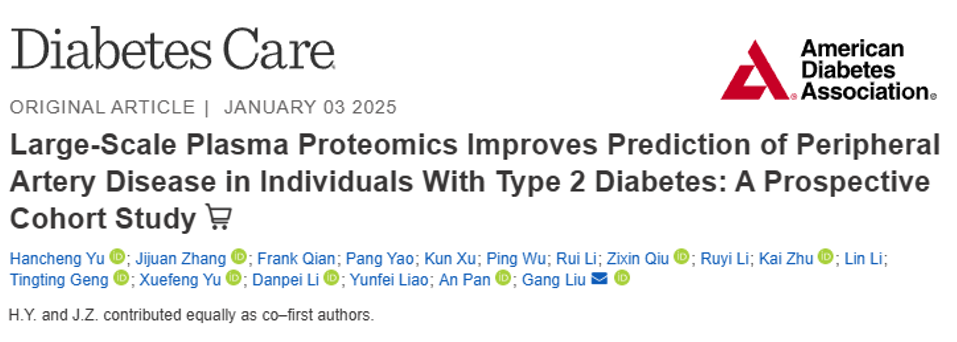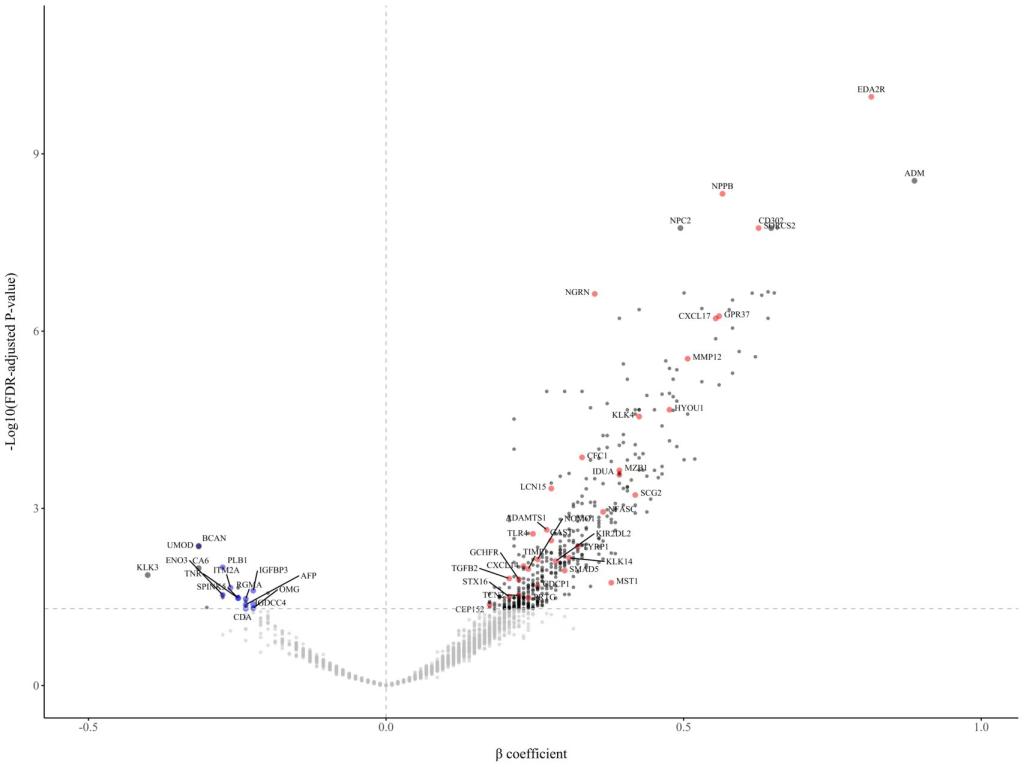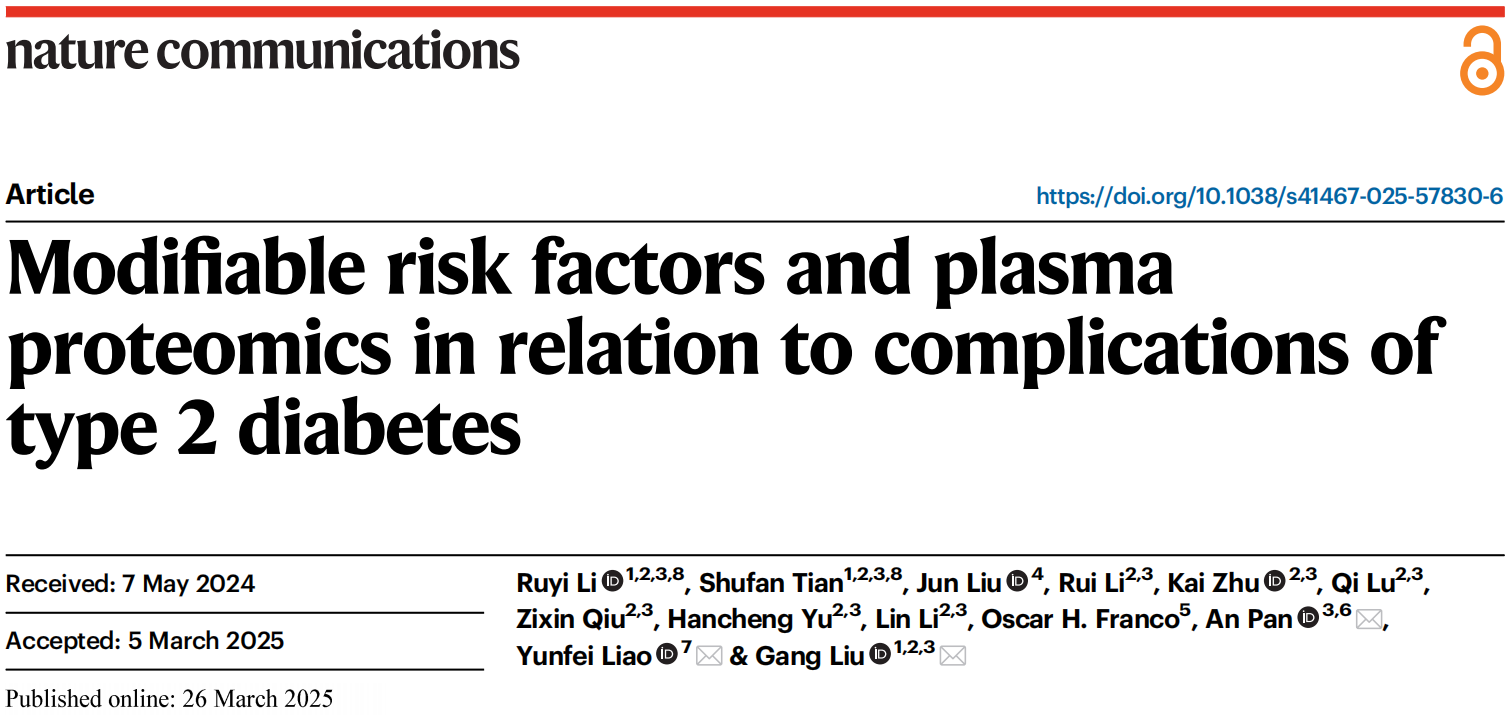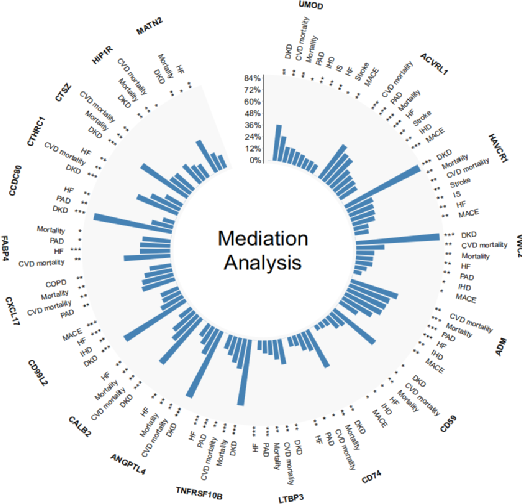People with type 2 diabetes (T2D) have increased risks of diabetic complications including cardiovascular diseases, peripheral artery disease (PAD), nephropathy, and retinopathy. Consequently, the early identification and prevention of these complications are of paramount importance. Recent advancements in proteomics have provided new opportunities for the identification of novel biomarkers, the exploration of underlying mechanisms, and the prediction of risks."
Recently, Professor Gang Liu's team from the School of Public Health at Huazhong University of Science and Technology has made significant advancements in proteomics and its application to diabetic complications. Their findings, published in the prestigious journals Diabetes Care and Nature Communications, demonstrate that proteomics can substantially improve the early prediction of PAD risk in patients with T2D. Furthermore, these studies highlights the pivotal role of proteomics in mediating the relationship between cardiovascular risk factors and the onset of diabetic complications. These results provide valuable scientific evidence to support the precise prevention and management of diabetic complications.
Proteomics enhances the prediction of peripheral artery disease risks in people with type 2 diabetes.
The international journal Diabetes Care recently published the latest research from Professor Gang Liu's team on proteomics and the prediction of diabetic complication risks. The study, titled 'Large-Scale Plasma Proteomics Improves Prediction of Peripheral Artery Disease in Individuals with Type 2 Diabetes: A Prospective Cohort Study', identified plasma proteins and their associated biological pathways linked to the development of PAD in people with T2D. Additionally, the research identified 45 protein biomarkers that significantly enhanced the predictive accuracy for PAD risk. Doctoral students Hancheng Yu and Jijuan Zhang from the School of Public Health are co-first authors, with Professor Gang Liu serving as the corresponding author.

PAD is a common complication among individuals with diabetes, significantly elevating the risk of lower limb amputation and mortality, and severely compromising quality of life. However, risk prediction models for PAD remain lacking.
Using data from a prospective cohort study, this research included 1,859 individuals with T2D and proteomics data encompassing 2,920 proteins, all of whom were free from prevalent PAD at baseline, with a mean age of 60.3 years. After a median follow-up of 13.2 years, 157 individuals (8.4%) developed PAD. Using Cox regression models adjusting for multiple confounding factors, the analyses identified 439 plasma proteins associated with an increased PAD risk and 24 proteins related to lower risks.
Pathway enrichment analysis revealed that the PAD-related proteins primarily participate in biological processes such as signal transduction, inflammatory response, protein binding, and cytokine-cytokine receptor interactions. Furthermore, a LASSO model was employed to select 45 proteins as predictors, which were used to form a weighted protein risk score (ProRS). In the validation set, incorporating these 45 protein biomarkers or the ProRS significantly improved the predictive accuracy of clinical models, increasing the C-index from 0.664 to 0.826–0.835.

▲Plasma proteins associated with the risk of peripheral artery disease in individuals with type 2 diabetes
Modifiable risk factors, plasma proteomics, and complications of type 2 diabetes
Recently, the leading international journal Nature Communications published the latest findings from Professor Gang Liu’s research team in a study titled “Modifiable risk factors, plasma proteomics and the association of Type 2 diabetes complications”. The research highlights that modifying lifestyle and cardiometabolic risk factors could confer health benefits across multiple organ systems in individuals with type 2 diabetes. Notably, several proteins, such as uromodulin (UMOD) and pro-adrenomedullin (ADM), were identified as key mediators in these associations.
Ruyi Li and Shufan Tian, postgraduate students from the School of Public Health, Tongji Medical College, Huazhong University of Science and Technology, are co-first authors of the paper. Professors Gang Liu, Yunfei Liao, and An Pan are co-corresponding authors.

Beyond glycemic control, the American Diabetes Association has emphasized the integral role of healthy lifestyles and optimal management of weight, blood pressure, and lipids in diabetes care. However, it is not well understood to what extent the combination of modifying lifestyle and cardiometabolic factors can reduce the risk of diabetes-related complications and mortality. In addition, the role of plasma proteomics in these associations also warrants further exploration.
This prospective study included 14,102 participants with type 2 diabetes, with a mean follow-up of 12.4 to 13.4 years. Researchers calculated a Cardiovascular Health (CVH) score based on the American Heart Association’s Life’s Essential 8 metrics (2022), which incorporate lifestyle behaviors (diet, physical activity, nicotine exposure, sleep) and cardiometabolic indicators (BMI, blood lipids, blood glucose, and blood pressure). The analysis assessed the relationships between CVH score and risks of 45 common complications of type 2 diabetes. The results indicated that higher CVH scores were associated with 10% to 31% lower risks for 30 outcomes, including macrovascular and microvascular complications, certain cancers, neurological and mental diseases, chronic obstructive pulmonary disease, and all-cause and cause-specific mortality.
Furthermore, proteomic analyses identified 632 of 2,915 plasma proteins that were significantly associated with the CVH score. Among LASSO-identified representative proteins, 39 proteins showed mediation effects on the associations between modifiable risk factors and various diabetes complications. These findings offer valuable insights into the precision prevention of diabetes complications.

▲The estimated mediation proportions of proteins on the associations of cardiovascular health score with adverse health conditions among participants with type 2 diabetes
The above research provides a new perspective for the early risk prediction and precision prevention of diabetes complications. The research was funded by the National Key Research and Development Program and the National Natural Science Foundation of China.
Link of the papers:
1. https://diabetesjournals.org/care/article-abstract/48/3/381/157604/Large-Scale-Plasma-Proteomics-Improves-Prediction?redirectedFrom=fulltext
2. https://www.nature.com/articles/s41467-025-57830-6

